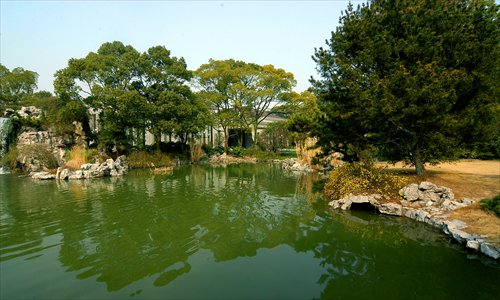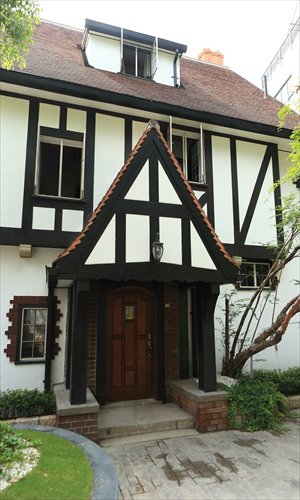The wonders of the west

Shanghai's Bund has been called the "World Expo of Architecture" for its varied architecture styles, but the city's western suburbs along Hongqiao Road could also claim this title. The area is home to more than 200 buildings of diverse and elegant architectural styles from all over the world. A recent 35-minute documentary, The Legend of West End, screened on the local Documentary Channel in 2012, explored the history of Shanghai's western suburbs. This is an area often described by some as the city's leafy tranquil garden that once was home to some of Shanghai's most powerful and wealthiest inhabitants.
At the turn of the 20th century, the Shanghai Municipal Council began building public roads to run through the city's international settlements. In 1901, Brenan Road (today's Changning Road) was constructed and named after Byron Brenan, the then British consul general in Shanghai. This was the city's first major thoroughfare linking the downtown area and the western suburbs.
After a Hungarian brought an American car from Hong Kong to Shanghai in 1903, the automobile became the must-have mode of transport for the city's elite. Within a decade with this easy mobility, many of the city's wealthy and established class began seeking respite from hectic city life and built retreats and resorts in the western suburbs where fresh air and greenery abounded.
An indelible mark
One of the city's most celebrated residents, Hungarian architect László Hudec was one of the first to leave an indelible mark on the city's western suburbs. In 1929, Hudec designed a Spanish-style villa for his family on Columbia Road (today's Panyu Road). The wood and brick Baroque-style building covered 8,000 square meters.
But the Hudec family never lived in this imposing grandiose home as the architect found himself in financial trouble at the time. He sold the house to Sun Ke, son of Sun Yat-sen, the founding father of the Republic of China (ROC, 1912-49).
However in the following year, Hudec built another smaller villa on the other side of the road and this was what he, and his wife Gisela Meyer and their three children used as their second residence in Shanghai from 1931 to 1936. The three-story, Tudor-style, whitewashed building stood out with dark wood half-timber frames highlighting the exterior.
With two towering red-brick chimneys at each end of the roof, three sets of Gothic windows, a round arched door on the ground floor, and a large garden in the south, the residence exuded a serene, idyllic rustic ambience.
In 2008 this Hudec home underwent a complete renovation and earlier this year it was opened to the public as the Hudec Memorial Hall. The exhibition hall now displays documents and photographs of Hudec and his family as well as examples of Hudec's classic architectural designs in Shanghai.
Another masterpiece that Hudec left in the city's western suburbs was the Catholic Country Church (Xi Yan Tang) on Rubicon Road (now Kele Road). Set beside the Xinjing River, the two-story church was built in 1925 with financial support from Chinese Catholic patriots including the noted educator Ma Xiangbo, who founded today's prestigious Fudan University.
A Byzantine-style church is a rare sight in Shanghai and this was a unique piece of Hudec's oeuvre. A true testimony to Hudec's mastery of different architectural styles, the Catholic Country Church features a stunning dome, a small bell tower and Gothic windows and arches.

Westerners' Cemetery
The church was originally known as the Chapel of the Westerners' Cemetery, the neighboring 50,000-square-meter cemetery which was the final resting place for people of all nationalities in Shanghai. There was also a mortuary with an underground passage to transfer coffins from the mortuary to the church for funeral services.
Today the mortuary has been turned into an office for the local Catholic community. The church still functions as a religious center, offering services for Catholics from all over Shanghai.
Another prominent resident of the western suburbs in those days was Victor Sassoon, one of the fourth generation of David Sassoon's family. The Sassoon family were Iraqi Jews based in Baghdad and had been one of the world's wealthiest families since the 18th century.
Although Victor inherited the family business in Shanghai, he built up his own empire with a wide range of businesses, most notably real estate.
One of the leading real estate businessmen in Shanghai in the early 20th century, Victor Sassoon's properties included the Hamilton Building and the Shanghai Metropole Hotel at the intersection of today's Fuzhou Road and Jiangxi Road Middle, the Cathay Theatre on Huaihai Road Middle, the Orient Hotel on Xizang Road Middle, and the Embankment Building on Suzhou Road North.
However, his most significant construction was Sassoon House on the Bund (now the Fairmont Peace Hotel). The 12-story structure was completed in 1929 at the cost of 5.6 million taels of silver and became the swankiest venue in the city offering luxury accommodation, fine dining and modern entertainment (including the legendary jazz band).
Soon after making his fortune in real estate, Victor Sassoon built his family estate on today's Hongqiao Road in 1932. Spreading over 60 hectares, the English country-style wood and brick villa was set in wooded land and meadows.

A poetic name
Sassoon's villa, poetically named the "Garden of Eden" to symbolize the plentiful fruits of the family's various businesses, was equipped with state-of-the-art facilities and it was estimated to have cost 317 silver dollars per square meter.
Victor Sassoon used to spend his weekends on his estate there playing golf or spending time with his thoroughbred horses. The Gatsby-like tycoon also liked to entertain friends by throwing lavish parties. Although he was injured in an aircraft accident in World War I (1914-18) and could only walk with canes, Victor enjoyed watching his friends dance at these parties.
The glamor and glory of the Sassoon estate vanished with the outbreak of the Pacific War (1941-45) and the villa was occupied by the Japanese army. When Japan surrendered in 1945, the estate was bought by the Shanghai financier and textile tycoon Li Shuxiong. Li turned the house into a private club, the Hongqiao Club, and the members were political and financial heavyweights from Shanghai and Nanjing. The club was closed at the end of 1948 when Li Shuxiong moved his family and business to Hong Kong. The villa was used as part of the Cypress Hotel during the 1980s until Li Shuxiong's descendants claimed the property which was returned to them in the 1990s.
Also on Hongqiao Road stood the residence of American Military Lieutenant General Claire Lee Chennault, the leader of the legendary Flying Tigers during World War II (1939-45). The Flying Tigers, officially known as the American Volunteer Group of the Chinese Air Force, flew over China to help battle the Japanese invaders during the War of Resistance against Japanese Aggression (1937-45).
In December 1947 Chennault married his Chinese wife Chen Xiangmei (Anna Chennault). Chen was some 32 years younger than Chennault and was a war correspondent for the Central News Agency of the ROC from 1944 to 1948.
They were married in his yellow-walled, red-roofed Tudor-style villa. The colorful wedding, replete with satin bows and a live orchestra, was a major social event for Shanghai. The couple stayed at their home until the spring of 1949. The villa is now Building 8 of the Shenkang Hotel.
Other classy homes in the city's western suburbs included the T. V. Soong Mansion (now the Red Bridge Gallery), owned by the first son of the influential Soong family, a prominent businessman and politician during the ROC period; and The Times Villa (today's Building 2 of the Cypress Hotel), a half-timbered British country house built by the London newspaper, The Times, as its residence and office in Shanghai in 1894. The building was later owned by the Chinese entrepreneur Rong Desheng.
A symbol of status
With western suburbs homes becoming a symbol of personal wealth, social status and privilege, and a better quality of life in the 1930s, the area also became a source of inspiration for many of the country's literary figures.
The leading Taiwanese writer and dramatist Pai Hsien-yung (son of Pai Chung-hsi, a prominent general with the Kuomintang), set his first short story Madame Ching (Jin Danainai) in Shanghai's western suburbs. Published in the magazine Literature in 1958, the story follows the tragic life of a widow.
Pai drew inspiration from his early memories of living in his father's residence on Hongqiao Road between 1946 and 1948 when he was a child. He stayed at the German-style building to recuperate from illness. This former residence is now a military hotel.
Another famous Chinese author who also wrote about the city's western suburbs was Eileen Chang. In Chang's 1951 novel of tragic love Eighteen Springs (or Half Life Fate), there is an important setting - the Zhu Mansion - a villa on Hongqiao Road which was home to Gu Manlu, the elder sister of the heroine.
Other major attractions of Shanghai's western suburbs are the Xijiao State Guest Hotel and the Shanghai Zoo. Opened in 1960, the Xijiao State Guest Hotel was then the city's largest five-star villa-style guesthouse and was surrounded by parklands. The hotel was once the exclusive haunt of Chinese leaders, including Mao Zedong and Deng Xiaoping.
In 1984, as Deng had actually proposed when he stayed there, the hotel opened to the public. Since then the Xijiao State Guest Hotel has welcomed a number of world leaders, including US presidents Barack Obama and George H. W. Bush, Queen Elizabeth II and former German chancellor Helmut Kohl.
One of the most eco-friendly parks in Shanghai, the Shanghai Zoo is home to more than 6,000 animals. The park was built on the site of the Hongqiao Golf Club, an exclusive sports and social club that opened in 1916. After the founding of the People's Republic of China in 1949, the golf club was reclaimed by the city government and was turned into Xijiao Park in 1953. The following year after an expansion project Xijiao Park became the Shanghai Zoo. After its opening thousands of people from Shanghai flocked to the new city landmark every day - and they still do.
Compiled by Yang Zhenqi